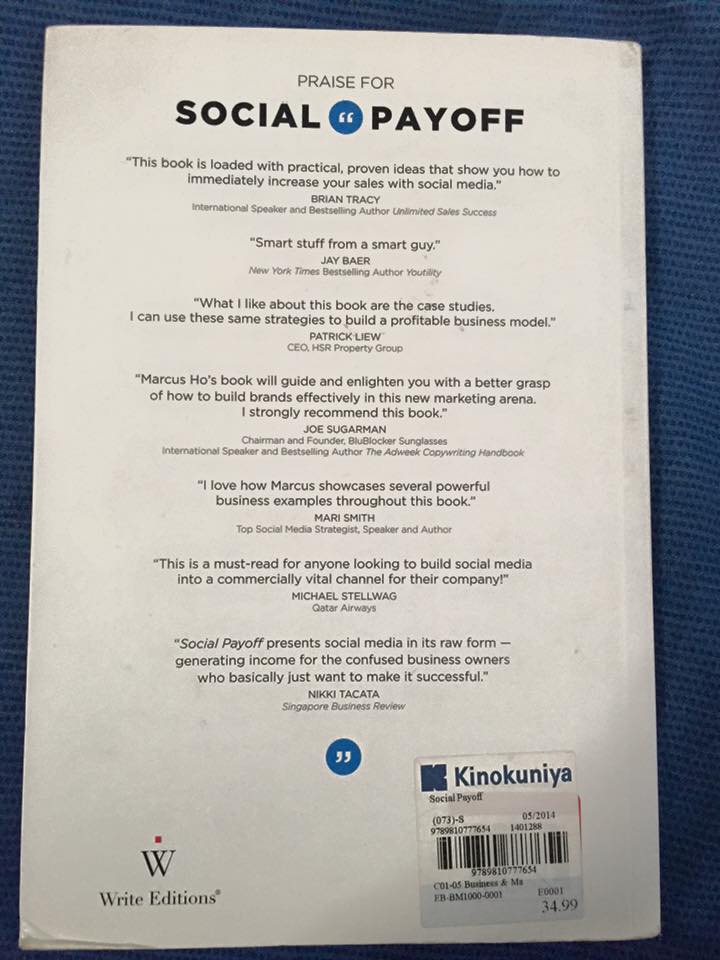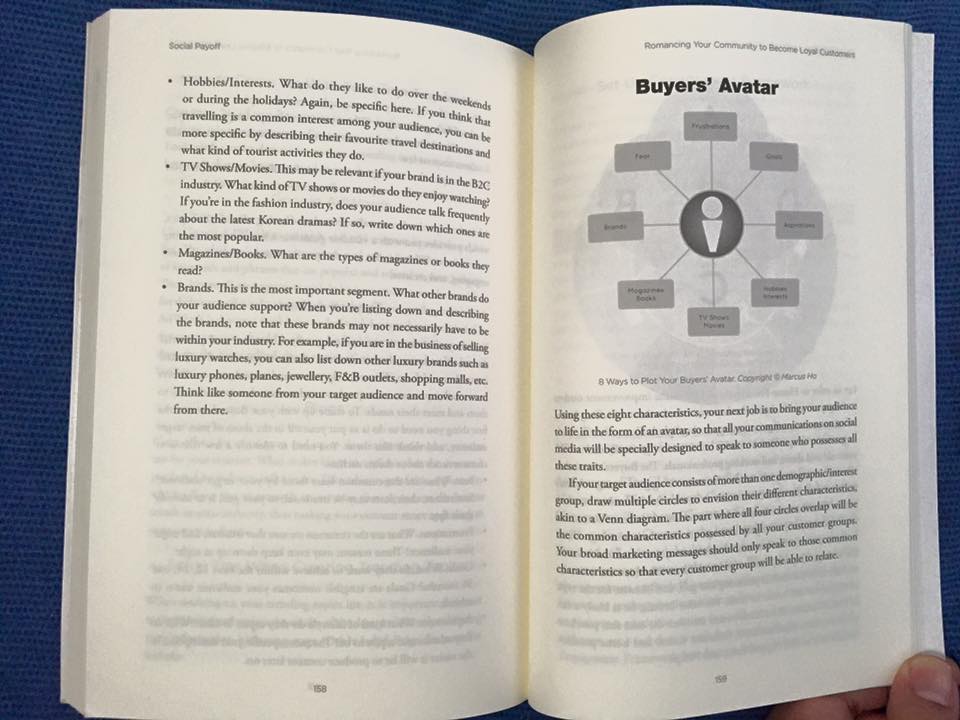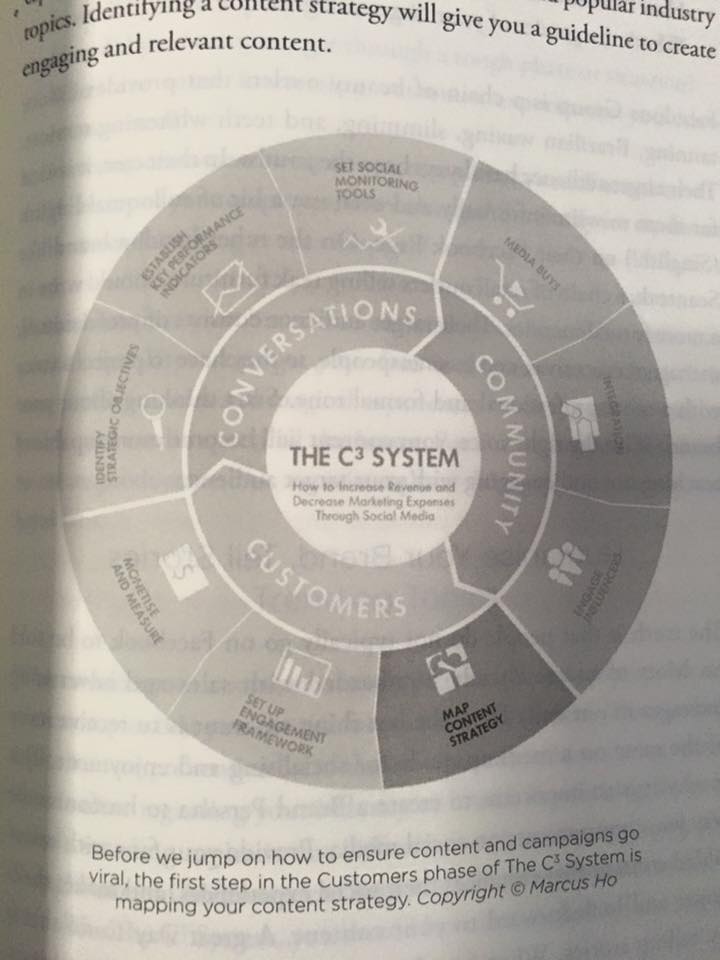
Should you borrow this book? No.
Should you get this book for free? Just skip to the list of social media tools.
“Social Payoff” by Marcus Ho is a book about how to execute social media strategies. It focuses mainly on Facebook strategies and to a much smaller degree, some Twitter strategies, although his recommendations are mainly for Facebook. It was published in 2014, which also explains the lack of coverage on Instagram and Google (though oddly he does make reference to it in the introduction).
There’s selling, and there’s overselling, and that’s the main problem with this book. The author makes promises at the beginning of the book that aren’t followed up by the end, the key thing being how to “boost sales.” It’s even on the cover of the book “Measure and cutting-edge strategies to boost sales.” His campaigns do achieve other results, such as the amount of chatter for the companies, or a reduction in marketing costs, but not sales. I’m not looking at customers or subscribers or cost-per-acquisition, but revenue or profit or sales. This is my primary beef with the book, and this was the very thing that attracted me to the book.

Highlights
List of social media tools
The book has a list of social media listening tools for you to do your media monitoring, and this is about the best thing of the book. It’s just a paragraph or two on each, and you’ll need to log in and figure out what works best for you on each platform, but this is a good place to start if you need to know how your company’s reputation stands on the Internet, apart from Facebook (or if it’s reputation exists).
Good book for introduction to social media
If you’re new to social media and unconvinced of how it can help you, and you really haven’t read any articles online about social media, then you’ll probably want to give it a go after reading this book. The author spends a huge portion of the book convincing you that social media is important to your company’s marketing strategy.
Examples of creative content
Since the author runs his own social media agency, he presents examples of campaigns that he’s run on social media. They are good examples of how to engage fans, and they do hit the ROIs of the project brief, so in that sense these are successful campaigns. But whether or not they are effective in boosting sales is up to you – the closest you get is an increase in the number of subscribers to a magazine that’s free.

Letdowns
An unbelievable amount of text dedicated to the pros of social media
If you’re picking this book up, chances are you’ll already be familiar with social media. So there’s no real reason to convince you that social media is important, otherwise, why would you be forking out $34.99 at Kinokuniya for a book about social media? It’s either padding, or the author doesn’t know his audience. And if the author doesn’t know the audience of his book, would you trust that he can guide you about catering to your audience?
Long-winded with lots of white space
Brevity is not the author’s strong suit, which again, is worrying for a social media marketer. Messages need to be punchy and impactful, none of which are evident here in this book. To top it off, there’s a lot of white space that appears due to bad formatting of images (basically, there’s not enough space on the page for an image, so it gets pushed to the next page, resulting in a chunk of white space where said image for supposed to go on the first page). Again, formatting and layout should be important to any marketer, so…
Oversells social media
The book treats social media like a magic bullet that will bring about unprecedented success for your company. The truth is that social media is just like any other marketing platform, and requires familiarity with that channel in addition to a lot of hard work. The hard work part is glossed over.
In one example, it urges online retailers to give a 50% discount in lieu of a 10% discount, using a product that costs $80 and sells for $200. With a 10% discount, the profit is $100 per sale, and with a 50% discount, the profit is $20 per sale. This means that, at the very least, you need at least 5 times the number of customers before this discount starts to pay off. And this doesn’t factor in the additional labour and administrative costs that’ll come from having to quintuple your sales just to make back the same amount of profit. And the rationale for this is “You may not make a huge profit in terms of sales immediately, but the opportunity to engage with new customers is worth the temporary decrease in profits. In the long run, your brand will stand to benefit tremendously. It really is a win-win situation.”
Firstly, saying it is really a win-win situation does not make it a win-win situation.
Secondly, you’re going to make a loss. It doesn’t say for how long you’re going to be making a loss, which is a problem, isn’t it? It also says that “in the long run, ….” but what is the long run in this case? A year? 5 years?
Thirdly, it’s common marketing knowledge that discounting hurts your brand and devalues your product in the eyes of the consumer, and trains them not to buy at full price and wait until you have a discount, unless your key selling point is a low price, of which then why wouldn’t you just go EDLP instead of discounts?
No hard examples of social media translating into sales
As mentioned earlier, there’s no case study in the book that shows this. They show increase in engagement online, but what about the increase in sales over the campaign period versus before? It’s difficult to show how social media marketing directly increases sales, that’s true. But that’s the entire reason why I’m reading this, because you made the claim on the cover of your book, and it’s a difficult task to achieve. The book talks about adding value to customers, but it doesn’t add value to its own customer, the reader.
The same image is repeated ad infinitum, with different portions highlighted.
Look, I get it, you’re proud of the C-cube system introduced in the book. But the author reprints that same image an ungodly number of times, highlighting a different portion to indicate that he’s talking about that section. The problem is that the print quality is bad (it’s horribly faint), the diagram isn’t that large, the font is small, and it’s full of buzzwords that need explanation. Is the book for beginners? Then why so many buzzwords? Is the book for experienced marketers? Then why the need to sell the importance of social media at the beginning?
Worst of all, every single image of this C-cube system must include “Copyright Marcus Ho” as if we didn’t know that already from the book cover. I can’t fathom the reason for it. Is it to remind us who wrote it? Is it a stern warning not to copy the image? Is it just to irritate you into ignoring the image (especially since it’s also the reason why so much white space is wasted)?

“Social Payoff” is a colossal disappointment. You’d do better just reading up on the Internet, experimenting with social media platforms yourself, and subscribing to news and updates on social media with that time spent.
Leave a Reply